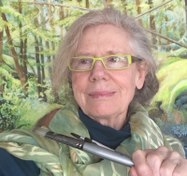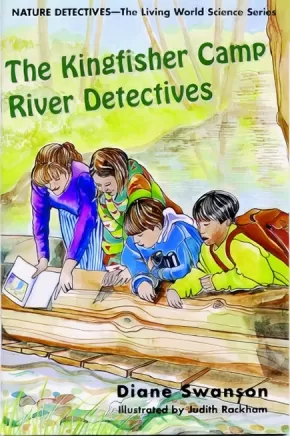Judith Rackham
Judith Rackham is an illustrator of natural history books for children. She has practised as a visual artist her entire life and is a member of the Federation of Canadian Artists. Her work can be found in several Vancouver Island galleries. For more information, visit judithrackhamart.com
Kids Books (2)

Synopsis:
Come with us for a walk along a secluded forest trail on a quiet night in May. We catch glimpses of ten animals as they move about in their woodland home from dusk until dawn. A mother cougar and her cub, a colony of bats, and a family of shrews are among the nighttime creatures we encounter. Beautiful full-page illustrations also depict many plants that live in this ecosystem. Information at the back of the book provides facts about nurse logs and the Pacific Northwest temperate rainforest.
A Night in Fernwood Forest is part of the By Day and By Night Nature Series. Books in this series focus on a specific habitat and explore the many connections within a healthy ecosystem. Through lyrical stories, supportive illustrations, labelled diagrams, and nature notes, readers learn about living and non-living parts of the ecosystem.
Additionally, readers can:
- use a picture clue on each page to predict the animal featured on the next page
- count animals as their numbers increase in each illustration
- search for an animal that travels from page to page
- discover patterns in the text and structure of each book
- track the movement of the sun or moon across the sky
Reviews
"Brenda Boreham brings her teaching experience and love of nature to these books, filling them with opportunities for the discovery of interactions between plants and animals in healthy ecosystems…. This beautiful book will engage listeners and independent readers and support the science goals in elementary school classrooms." – Canadian Teacher Magazine, Winter 2024 issue
Readers with a sense of curiosity will find opportunities in these books to:
- use picture clues to predict the featured animal on the next page
- identify, count, and sequence numbers (1 owl, 2 deer, 3 squirrels, etc.)
- search for small creatures that travel from page to page
- discover patterns in the text and structure of the books
- track the movement of the sun, or moon, across the sky
Curriculum Links
Reading - Providing opportunities for guided practise in using reading strategies: visualizing, making connections, asking questions, transforming, and inferring.
Science - Supporting discussion and further exploration:
- characteristics of living things
- needs of living things
- connections between living and non-living things
- daily and seasonal changes
- animal growth and changes
- plant growth and changes
- weather
- habitats
- observable patterns in the sky
Numeracy - Counting and sequencing of numbers 1 to 10.
Social Responsibility - Initiating discussions about ways to take care of wilderness areas.
32 Pages | 8.5" x 11" | Hardcover | ISBN: 9781771746021
Synopsis:
The Kingfisher Camp River Detectives shows how plants and animals interact and adapt themselves to the river. It shows how living things depend on non-living things, such as water, light, sand and gravel. Young children will take delight in discovering that;
Black cottonwood trees thrive in damp riverbanks.
Belted kingfishers dive into rivers after fish.
Quartz in river sandstone is harder than a knife blade.
Bears beat paths to waterfalls to catch salmon.
The book also presents examples of river fossils, First Nations' uses of river life and the ways people harm and help the river.
Educator & Series Information
This book is part of The Nature Detectives Series.








